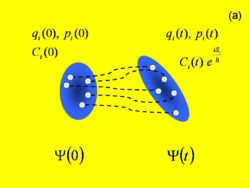Multidimensional quantum mechanics
Rapid increase of basis set with the number of quantum degrees of freedom is the central problem of computational quantum mechanics. Typically the basis increases with the number of degrees of freedom M as
where l is the number of basis function required for similar 1D problem. Exponential scaling makes quantum mechanics of many body systems very hard computationally. This project is focused on the methods which avoid exponential curse of quantum dynamics. The ambition of the project is to create quantum analog of classical molecular dynamics capable of solving the time-dependent Schrödinger Equation for systems comprised of large number of quantum particles.
Coupled Coherent States
In the recent years we have been developing a new Coupled Coherent States (CCS) approach to multidimensional many body quantum dynamics, which exploits the properties of trajectory guided grids of Gaussian wave packets (i.e. coherent states) as a basis set for the coupled quantum equations as illustrated at the figure below.

The main advantage is that the initial conditions can be chosen randomly, which results in a good (ideally quadratic N~M2) scaling. Second, certain cancellations appear in the coupling equations. Third, classical mechanics always keeps the basis in the dynamically important region.
Previous Applications
A number of multidimensional applications to the spectroscopy of polyatomic molecules and small clusters, intramolecular vibrational energy redistribution, proton tunneling have been reported. These include:
1) simulations of tunneling splitting (up to 20D) [1]
2) simulations of Franck-Condon spectra of Henon-Heiles model (up to 32D) [2] and pyrazine (4D and 24D models) [3]
3) simulation of infrared absorption specrum [4]
4) simulation of intramolecular vibrational energy redistribution (9D) [5]
5) simulation of electronic energy levels (6D) [6]
as well as a number of low dimensionality model calculations. The method has been reviewed in [7]
Applications in progress include simulation of electron double ionization dynamics in strong laser field using new Fermionic CCS.
Multi-Configurational Ehrenfest Dynamics
Multi-Configurational Ehrenfest Dynamics is a generalisation of the CCS method for the case of nonadiabatic dynamics. MCE simulations have been performed for
1) Spin-Boson model (up to 2000D) [8]
2) Franck-Condon absorption spectrum of the pyrazine molecule (24D) [9]
3) Recently we implemented MCE in the form of "on-the-fly" ab initio dynamics [10,11]
Fermion CCS
In our recent work with Adam Kirrander we developed a new approach to dynamics of electrons in laser field. The technique uses Coupled Fermionic Coherent States which are modified to include proper permutational symmetry [12]. It allowed us to look at the attosecond dynamics in strong lasef field for the pulses with very long duration, which is very difficult for other quantum techniques.
Reviews
You can find more in the reviews [7, 13].
Code
Two versions of the CCS code are available for download.
1) The CCS code 1 is a very primitive code which has been used to simulate Henon-Heiles model and later served as a starting point for many other projects.
2) The CCS code 2 was developed by Stewart Reed. It is much more sophisticated and can be run in parallel. The manual is available.
3) The Multiconficurational Ehrenfest Code developed by Christopher Symonds is also available.
If you have questions please do not hesitate to contact Dr Dmitry Shalashilin, Dr Stewart Reed , and Dr Christopher Symonds.
References
[1] Sherratt PAJ , Shalashilin DV, Child MS, Description of multidimensional tunnelling with the help of coupled coherent states guided by classical Hamiltonians with quantum corrections Chem.Phys. 322 (2006) 127; [2] Shalashilin DV, Child MS, Basis set sampling in the method of coupled coherent states: Coherent state swarms, trains, and pancakes ; J.Chem.Phys. 128 (2008) 054102; [3] Shalashilin DV, Child MS, Real time quantum propagation on a Monte Carlo trajectory guided grids of coupled coherent states: 26D simulation of pyrazine absorption spectrum J.Chem.Phys. 121 (2004) 3563; [4] Shalashilin DV, Child MS, Clary DC, Quantum initial value representation simulation of water trimer far infrared absorption spectrum J.Chem.Phys. 120 (2004) 5608; [5] Shalashilin DV, Child MS, Nine-dimensional quantum molecular dynamics simulation of intramolecular vibrational energy redistribution in the CHD3 molecule with the help of coupled coherent states J.Chem.Phys. 119 (2003) 1961; [6] Shalashilin DV, Child MS, Electronic energy levels with the help of trajectory guided random grid of coupled wave packets I Six-dimensional simulation of H-2; J.Chem.Phys. 122 (2005) 224108; [7] Shalashilin DV, Child MS, The phase space CCS approach to quantum and semiclassical molecular dynamics for high-dimensional systems; Chem.Phys. 304 (2004) 103; [8] Shalashilin DV, Quantum mechanics with the basis set guided by Ehrenfest trajetories. Theory and application to spin-boson model J. Chem. Phys. 130 (2009): 244101; [9] Shalashilin DV, Nonadiabatic dynamics with the help of multiconfigurational Ehrenfest method. Fully quantum 24D simulation of pyrazine. J. Chem. Phys. 132 244111 (2010); [10] Saita K, Shalashilin DV, On-the-fly ab initio molecular dynamics with multiconfigurational Ehrenfest method; J. Chem. Phys. 137 (2012) 22A506; [11] Makhov DV, Glover WJ, Martinez TJ, Shalashilin DV, Ab initio multiple cloning algorithm for quantum nonadiabatic molecular dynamics, J.Chem.Phys. 141 (2014) 054110; [12] Kirrander A, Shalashilin DV, Quantum dynamics with fermion coupled coherent states. Theory and application to electron dynamics in laser field; Phys. Rev. A 84 (2011) 033406; [13] Makhov DV, Symonds C, Fernandez-Alberti S, Shalashilin DV, Ab initio quantum direct dynamics simulations of ultrafast photochemistry with Multiconfigurational Ehrenfest approach; Chem.Phys493 (2017) 200-218.
